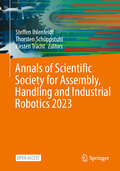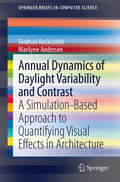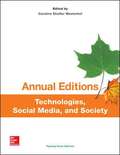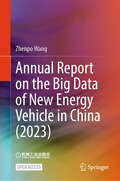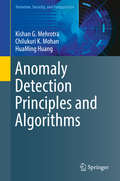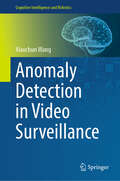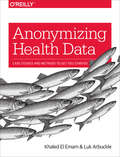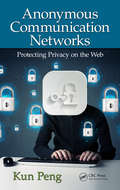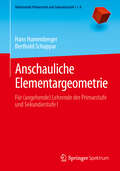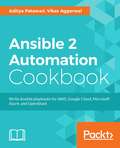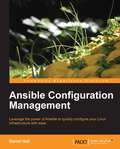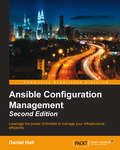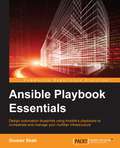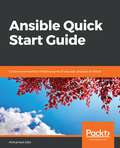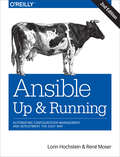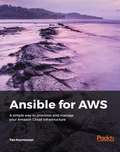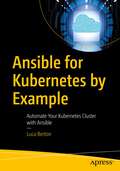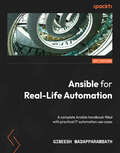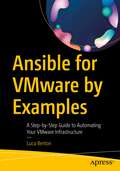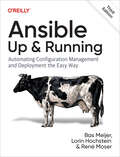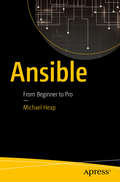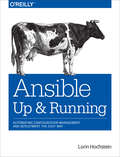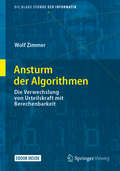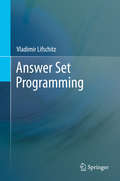- Table View
- List View
Annals of Scientific Society for Assembly, Handling and Industrial Robotics 2023
by Thorsten Schüppstuhl Kirsten Tracht Steffen IhlenfeldtThis open access book presents a good overview of the current research landscape of assembly, handling and industrial robotics. The objective of MHI Colloquium is the successful networking at both academic and management levels. Thereby, the colloquium focuses an academic exchange at a high level in order to distribute the obtained research results, to determine synergy effects and trends, to connect the actors in person and in conclusion, to strengthen the research field as well as the MHI community. In addition, there is the possibility to become acquainted with the organizing institute. Primary audience is formed by members of the scientific society for assembly, handling and industrial robotics (WGMHI).
Annotation-Based Semantics for Space and Time in Language (Studies in Natural Language Processing)
by Kiyong LeeSpace and time representation in language is important in linguistics and cognitive science research, as well as artificial intelligence applications like conversational robots and navigation systems. This book is the first for linguists and computer scientists that shows how to do model-theoretic semantics for temporal or spatial information in natural language, based on annotation structures. The book covers the entire cycle of developing a specification for annotation and the implementation of the model over the appropriate corpus for linguistic annotation. Its representation language is a type-theoretic, first-order logic in shallow semantics. Each interpretation model is delimited by a set of definitions of logical predicates used in semantic representations (e.g., past) or measuring expressions (e.g., counts or k). The counting function is then defined as a set and its cardinality, involving a universal quantification in a model. This definition then delineates a set of admissible models for interpretation.
Annual Dynamics of Daylight Variability and Contrast: A Simulation-Based Approach to Quantifying Visual Effects in Architecture (SpringerBriefs in Computer Science)
by Marilyne Andersen Siobhan RockcastleDaylight is a dynamic source of illumination in architectural space, creating diverse and ephemeral configurations of light and shadow within the built environment. Perceptual qualities of daylight, such as contrast and temporal variability, are essential to our understanding of both material and visual effects in architecture. Although spatial contrast and light variability are fundamental to the visual experience of architecture, architects still rely primarily on intuition to evaluate their designs because there are few metrics that address these factors. Through an analysis of contemporary architecture, this work develops a new typological language that categorizes architectural space in terms of contrast and temporal variation. This research proposes a new family of metrics that quantify the magnitude of contrast-based visual effects and time-based variation within daylit space through the use of time-segmented daylight renderings to provide a more holistic analysis of daylight performance.
Annual Editions: Technologies, Social Media, And Society, 21/e
by Caroline Shaffer WesterhofThe Annual Editions series is designed to provide convenient, inexpensive access to a wide range of current articles from some of the most respected magazines, newspapers, and journals published today. Annual Editions are updated on a regular basis through a continuous monitoring of over 300 periodical sources. The articles selected are authored by prominent scholars, researchers, and commentators writing for a general audience.
Annual Report on the Big Data of New Energy Vehicle in China (2023)
by Zhenpo WangThis open access book, based on static indicators and dynamic big data from local electric vehicles, is the first research annual report on the Big Data of New Energy Vehicles (NEVs) in China. Using the real-time big data collected by China's National Monitoring and Management Platform for NEVs, this book delves into the main annual technological progress of NEVs, the vehicle operating characteristics, and it also anticipates the trend of NEVs industry. Various graphs and charts and detailed data this book will familiarize readers with the operation characteristics and practical application of China's NEVs industry and popularize the concept of automobile electrification. Besides, this book also makes an objective evaluation of the current situation and technological improvement of China's NEVs industry, presenting sensible suggestions for the development of the industry. This book is written for government staff, researchers, college staff, and technical staff of automobile and spare parts enterprises, which serves as an important reference for the decision-making of government departments and strategic decisions of automotive companies.
Anomaly Detection Principles and Algorithms (Terrorism, Security, and Computation)
by Chilukuri K. Mohan Kishan G. Mehrotra HuaMing HuangThis book provides a readable and elegant presentation of the principles of anomaly detection,providing an easy introduction for newcomers to the field. A large number of algorithms are succinctly described, along with a presentation of their strengths and weaknesses. The authors also cover algorithms that address different kinds of problems of interest with single and multiple time series data and multi-dimensional data. New ensemble anomaly detection algorithms are described, utilizing the benefits provided by diverse algorithms, each of which work well on some kinds of data. With advancements in technology and the extensive use of the internet as a medium for communications and commerce, there has been a tremendous increase in the threats faced by individuals and organizations from attackers and criminal entities. Variations in the observable behaviors of individuals (from others and from their own past behaviors) have been found to be useful in predicting potential problems of various kinds. Hence computer scientists and statisticians have been conducting research on automatically identifying anomalies in large datasets. This book will primarily target practitioners and researchers who are newcomers to the area of modern anomaly detection techniques. Advanced-level students in computer science will also find this book helpful with their studies.
Anomaly Detection in Video Surveillance (Cognitive Intelligence and Robotics)
by Xiaochun WangAnomaly detection in video surveillance stands at the core of numerous real-world applications that have broad impact and generate significant academic and industrial value. The key advantage of writing the book at this point in time is that the vast amount of work done by computer scientists over the last few decades has remained largely untouched by a formal book on the subject, although these techniques significantly advance existing methods of image and video analysis and understanding by taking advantage of anomaly detection in the data mining community and visual analysis in the computer vision community. The proposed book provides a comprehensive coverage of the advances in video based anomaly detection, including topics such as the theories of anomaly detection and machine perception for the functional analysis of abnormal events in general, the identification of abnormal behaviour and crowd abnormal behaviour in particular, the current understanding of computer vision development, and the application of this present understanding towards improving video-based anomaly detection in theory and coding with OpenCV. The book also provides a perspective on deep learning on human action recognition and behaviour analysis, laying the groundwork for future advances in these areas. Overall, the chapters of this book have been carefully organized with extensive bibliographic notes attached to each chapter. One of the goals is to provide the first systematic and comprehensive description of the range of data-driven solutions currently being developed up to date for such purposes. Another is to serve a dual purpose so that students and practitioners can use it as a textbook while researchers can use it as a reference book. A final goal is to provide a comprehensive exposition of the topic of anomaly detection in video media from multiple points of view.
Anonymizing Health Data: Case Studies and Methods to Get You Started
by Luk Arbuckle Khaled El EmamUpdated as of August 2014, this practical book will demonstrate proven methods for anonymizing health data to help your organization share meaningful datasets, without exposing patient identity. Leading experts Khaled El Emam and Luk Arbuckle walk you through a risk-based methodology, using case studies from their efforts to de-identify hundreds of datasets.Clinical data is valuable for research and other types of analytics, but making it anonymous without compromising data quality is tricky. This book demonstrates techniques for handling different data types, based on the authors’ experiences with a maternal-child registry, inpatient discharge abstracts, health insurance claims, electronic medical record databases, and the World Trade Center disaster registry, among others.Understand different methods for working with cross-sectional and longitudinal datasetsAssess the risk of adversaries who attempt to re-identify patients in anonymized datasetsReduce the size and complexity of massive datasets without losing key information or jeopardizing privacyUse methods to anonymize unstructured free-form text dataMinimize the risks inherent in geospatial data, without omitting critical location-based health informationLook at ways to anonymize coding information in health dataLearn the challenge of anonymously linking related datasets
Anonymous Communication Networks: Protecting Privacy on the Web
by Kun PengIn today's interactive network environment, where various types of organizations are eager to monitor and track Internet use, anonymity is one of the most powerful resources available to counterbalance the threat of unknown spectators and to ensure Internet privacy.Addressing the demand for authoritative information on anonymous Internet usage, Ano
Anschauliche Elementargeometrie: Für (angehende) Lehrende der Primarstufe und Sekundarstufe I (Mathematik Primarstufe und Sekundarstufe I + II)
by Berthold Schuppar Hans HumenbergerDieses Lehrbuch unterstützt bei der Vorbereitung eines reizvollen, lebendigen und problemorientierten Geometrieunterrichts in der Primarstufe und Sekundarstufe I. Es macht die entsprechenden Sachverhalte der Elementargeometrie zugänglich und erlebbar, indem geometrische Figuren beschrieben, konstruiert, variiert und analysiert und die beobachteten Phänomene möglichst anschaulich begründet werden. Die vorgeschlagenen Experimente verwenden dabei diverse Materialien – von Papier und Pappe (Falten, Schneiden, Kleben) über klassische Konstruktionen mit Zirkel und Lineal bis hin zur dynamischen Geometrie-Software (DGS) GeoGebra. Entsprechende Grundkenntnisse im Umgang mit GeoGebra werden dabei vorausgesetzt. Im gesamten Buch stehen problemorientierte Ansätze, entdeckendes Lernen, Forschungsaufträge und Anwendungen im Vordergrund. In den ersten Kapiteln werden die zentralen Ziele, Inhalte und Methoden vorgestellt sowie die Inhalte der Schulgeometrie wiederholt. In den späteren Kapiteln werden diese auf einem etwas höheren mathematischen Niveau systematisiert und erweitert, jedoch nicht im Sinne einer axiomatischen Geometrie. Das Buch richtet sich vorrangig an Studierende des Lehramts der Primarstufe und Sekundarstufe I bzw. an Grund-, Haupt- und Realschulen sowie an Lehrende in diesem Bereich.
Ansible 2 Cloud Automation Cookbook: Write Ansible playbooks for AWS, Google Cloud, Microsoft Azure, and OpenStack
by Aditya Patawari Vikas AggarwalOrchestrate your cloud infrastructure Key Features Recipe-based approach to install and configure cloud resources using Ansible Covers various cloud-related modules and their functionalities Includes deployment of a sample application to the cloud resources that we create Learn the best possible way to manage and automate your cloud infrastructure Book Description Ansible has a large collection of inbuilt modules to manage various cloud resources. The book begins with the concepts needed to safeguard your credentials and explain how you interact with cloud providers to manage resources. Each chapter begins with an introduction and prerequisites to use the right modules to manage a given cloud provider. Learn about Amazon Web Services, Google Cloud, Microsoft Azure, and other providers. Each chapter shows you how to create basic computing resources, which you can then use to deploy an application. Finally, you will be able to deploy a sample application to demonstrate various usage patterns and utilities of resources. What you will learn Use Ansible Vault to protect secrets Understand how Ansible modules interact with cloud providers to manage resources Build cloud-based resources for your application Create resources beyond simple virtual machines Write tasks that can be reused to create resources multiple times Work with self-hosted clouds such as OpenStack and Docker Deploy a multi-tier application on various cloud providers Who this book is for If you are a system administrator, infrastructure engineer, or a DevOps engineer who wants to obtain practical knowledge about Ansible and its cloud deliverables, then this book is for you. Recipes in this book are designed for people who would like to manage their cloud infrastructures efficiently using Ansible, which is regarded as one of the best tools for cloud management and automation.
Ansible Configuration Management
by Daniel HallAnsible Configuration Management" is a step-by-step tutorial that teaches the use of Ansible for configuring Linux machines.This book is intended for anyone looking to understand the basics of Ansible. It is expected that you will have some experience of how to set up and configure Linux machines. In parts of the book we cover configuration files of BIND, MySQL, and other Linux daemons, therefore a working knowledge of these would be helpful but are certainly not required.
Ansible Configuration Management - Second Edition
by Daniel HallThis book is intended for anyone who wants to learn Ansible starting from the basics. Some experience of how to set up and configure Linux machines and a working knowledge of BIND, MySQL, and other Linux daemons is expected.
Ansible Playbook Essentials
by Gourav ShahIf you are a systems or automation engineer who intends to automate common infrastructure tasks, deploy applications, and use orchestration to configure systems in a coordinated manner, then this book is for you. Some understanding of the Linux/Unix command-line interface is expected.
Ansible Quick Start Guide: Control and monitor infrastructures of any size, physical or virtual
by Mohamed AlibiConfigure Ansible and start coding YAML playbooks using the appropriate modulesKey FeaturesCreate and use Ansible Playbook to script and organise management tasksBenefit from the Ansible community roles and modules to resolve complex and niche tasksWrite configuration management code to automate infrastructureBook DescriptionConfiguration Management (CM) tools help administrators reduce their workload. Ansible is one of the best Configuration Management tools, and can act as an orchestrator for managing other CMs. This book is the easiest way to learn how to use Ansible as an orchestrator and a Configuration Management tool. With this book, you will learn how to control and monitor computer and network infrastructures of any size,physical or virtual. You will begin by learning about the Ansible client-server architecture. To get started, you will set up and configure an Ansible server. You will then go through the major features of Ansible: Playbook and Inventory. Then, we will look at Ansible systems and network modules. You will then use Ansible to enable infrastructure automated configuration management, followed by best practices for using Ansible roles and community modules. Finally, you will explore Ansible features such as Ansible Vault, Ansible Containers, and Ansible plugins.What you will learnImplement Playbook YAML scripts and its capacities to simplify day-to-day tasksSetup Static and Dynamic InventoryUse Ansible predefined modules for Linux, Windows, networking, and virtualisation administrationOrganize and configure the host filesystem using storage and files modulesImplement Ansible to enable infrastructure automated configuration managementSimplify infrastructure administrationSearch and install new roles and enable them within AnsibleSecure your data using Ansible VaultWho this book is forThis book is targeted at System Administrators and Network Administrators who want to use Ansible to automate an infrastructure. No knowledge of Ansible is required.
Ansible Up and Running: Automating Configuration Management and Deployment the Easy Way (2nd Edition)
by Lorin Hochstein Rene MoserAmong the many configuration management tools available, Ansible has some distinct advantages—it’s minimal in nature, you don’t need to install anything on your nodes, and it has an easy learning curve. With this updated second edition, you’ll learn how to be productive with this tool quickly, whether you’re a developer deploying code to production or a system administrator looking for a better automation solution.Authors Lorin Hochstein and René Moser show you how to write playbooks (Ansible’s configuration management scripts), manage remote servers, and explore the tool’s real power: built-in declarative modules. You’ll discover that Ansible has the functionality you need—and the simplicity you desire.Manage Windows machines, and automate network device configurationManage your fleet from your web browser with Ansible TowerUnderstand how Ansible differs from other configuration management systemsUse the YAML file format to write your own playbooksWork with a complete example to deploy a non-trivial applicationDeploy applications to Amazon EC2 and other cloud platformsCreate Docker images and deploy Docker containers with AnsibleThis book is best read start to finish, with later chapters building on earlier ones. Because it’s written in a tutorial style, you can follow along on your own machine. Most examples focus on web applications.
Ansible for AWS
by Yan KurniawanA simple way to provision and manage your Amazon Cloud infrastructure About This Book * Get started with AWS management for infrastructure engineers * Explore techniques to set up and manage your private cloud using Ansible * A practical guide to help you manage AWS-based applications and infrastructure using Ansible Who This Book Is For If you are an infrastructure engineer, system administrator, or Dev Ops engineer, this book is for you. You will find this book helpful if you have previous experience with Linux systems administration, including familiarity with the command line, file system, and text editing. Prior basic knowledge of Amazon Web Services and some experience with Ansible is assumed. What You Will Learn * Set up your own AWS account and get started with the AWS console * Use Ansible Playbook to configure and launch EC2 instances * Delve deeper into the AWS cloud infrastructure and create and manage VPC * Provision Amazon Relational Database Service (RDS) with Ansible * Manage files in an Amazon Simple Storage Service (S3) bucket using Ansible * Extend Ansible's functionality in the AWS environment * Use Ansible to provision ELB and Auto Scaling groups * Manage IAM users, groups, roles, and keys * See how to refine and chain together AWS tools using Ansible In Detail Looking to get a simple and efficient way to manage your Amazon Cloud infrastructure? Ansible is exactly what you need. This book will show you how to use Ansible's cloud modules to easily provision and manage AWS resources including EC2, VPC, RDS, S3, ELB, ElastiCache, and Route 53. We'll take you beyond the basics of Ansible, showing you real-world examples of AWS infrastructure automation and management with detailed steps, complete code, and screen captures from the AWS console. The example projects inside this title will help you grasp the process leading to full AWS automation. From a single WordPress site to a highly available and scalable WordPress site, we'll demonstrate the power of using Ansible to provision and automate AWS-based infrastructure deployment. Style and approach This hands-on guide will help you get acquainted with techniques to implement AWS for your private cloud.
Ansible for Kubernetes by Example: Automate Your Kubernetes Cluster with Ansible
by Luca BertonLearn how to automate your Kubernetes infrastructure using Ansible. This book will enable you to automate more tasks and save time with this human-readable platform. Containerized microservices deployed via Kubernetes allows you to save time, reduce human interaction and errors, and create applications that are more robust. You’ll learn how to automate the most redundant activities such as reports, services, the launch of a pod, adding permanent storage, configuring load balancing, and adding or modifying any Kubernetes parameter. You'll also gain an understanding of end-to-end use cases and how advanced cluster automation, such as Helm packages and node states, are evolving. Each lesson utilizes a specific use-case for the modern Kubernetes cluster and focuses on a single module from the most crucial parameter, complete with code demonstrations. Each code example is battle-proven in real-life with console interaction and verification.What You'll LearnAutomate Kubernetes cluster management, cloud services, pods, and storage with AnsibleConfigure your Ansible controller nodeWrite and execute Ansible Playbook code that follows best practicesAugment your productivity by applying Infrastructure as Code (IaC)Troubleshoot Ansible Who This Book Is ForIT professionals who would like a jargon-free understanding of Ansible technology, Windows Systems Administrators, DevOps professionals, thought leaders, and infrastructure-as-code enthusiasts.
Ansible for Real-Life Automation: A complete Ansible handbook filled with practical IT automation use cases
by Gineesh MadapparambathLearn how to automate and manage your IT infrastructure and applications using AnsibleKey FeaturesDevelop Ansible automation use cases by automating day-to-day IT and application operationsUse Ansible to automate private and public cloud, application containers, and container platformsImprove your DevOps workflow with AnsibleBook DescriptionGet ready to leverage the power of Ansible's wide applicability to automate and manage IT infrastructure with Ansible for Real-Life Automation. This book will guide you in setting up and managing the free and open source automation tool and remote-managed nodes in the production and dev/staging environments.Starting with its installation and deployment, you'll learn automation using simple use cases in your workplace. You'll go beyond just Linux machines to use Ansible to automate Microsoft Windows machines, network devices, and private and public cloud platforms such as VMWare, AWS, and GCP. As you progress through the chapters, you'll integrate Ansible into your DevOps workflow and deal with application container management and container platforms such as Kubernetes. This Ansible book also contains a detailed introduction to Red Hat Ansible Automation Platform to help you get up to speed with Red Hat AAP and integration with CI/CD and ITSM.What's more, you'll implement efficient automation solutions while learning best practices and methods to secure sensitive data using Ansible Vault and alternatives to automate non-supported platforms and operations using raw commands, command modules, and REST API calls.By the end of this book, you'll be proficient in identifying and developing real-life automation use cases using Ansible.What you will learnExplore real-life IT automation use cases and employ Ansible for automationDevelop playbooks with best practices for production environmentsApproach different automation use cases with the most suitable methodsUse Ansible for infrastructure management and automate VMWare, AWS, and GCPIntegrate Ansible with Terraform, Jenkins, OpenShift, and KubernetesManage container platforms such as Kubernetes and OpenShift with AnsibleGet to know the Red Hat Ansible Automation Platform and its capabilitiesWho this book is forThis book is for DevOps and systems engineers looking to adopt Ansible as their automation tool. To get started with this book, basic knowledge of Linux is necessary, along with an understanding of how tasks are done the manual way before setting out to automate them.
Ansible for VMware by Examples: A Step-by-Step Guide to Automating Your VMware Infrastructure
by Luca BertonLearn to use the Ansible open source IT automation tool to automate your VMware infrastructure. This book contains all of the obvious and not-so-obvious best practices of Ansible automation. Each lesson summarizes a specific use case for the modern VMware infrastructure and is focused on a single module from the most important parameter, including live demo of code and real-life usage.You'll configure the Ansible Controller to interact with VMware infrastructure using the “community.VMware” Ansible documentation collection and the appropriate Python libraries. Next, learn how to automate the creation of a virtual machine manually and from a template, start and stop using the shutdown and forced-power off a Virtual Machine, take and delete and snapshot, add a new hard disk and expand a currently attached hard disk, as well as gather information for data centers, clusters, host systems, and virtual machines.By the end of this book, you'll be well-versed in efficiently maintaining a VMware infrastructure with Ansible Automation. You'll also be able to save time and reduce manual errors using simple human-readable automation technology.What You'll LearnAutomate your VMware infrastructure using Ansible codeInstall Ansible in operating systems such as RedHat, Ubuntu, Fedora, etc.Write and execute your first Ansible Playbook code Troubleshoot the most common error messagesWho This Book Is For IT professionals of every industry who would like a jargon-free understanding of Ansible technology, including VMware, Linux, and Windows Systems Administrators, DevOps professionals, thought leaders, and infrastructure-as-code enthusiasts.
Ansible: Automating Configuration Management and Deployment the Easy Way
by Lorin Hochstein Bas Meijer René MoserAmong the many configuration management tools available, Ansible has some distinct advantages: It's minimal in nature. You don't need to install agents on your nodes. And there's an easy learning curve. With this updated third edition, you'll quickly learn how to be productive with Ansible whether you're a developer deploying code or a system administrator looking for a better automation solution.Authors Bas Meijer, Lorin Hochstein, and Rene Moser show you how to write playbooks (Ansible's configuration management scripts), manage remote servers, and explore the tool's real power: built-in declarative modules. You'll learn how Ansible has all the functionality you need--and the simplicity you desire.Explore Ansible configuration management and deploymentManage Linux, Windows, and network devicesLearn how to apply Ansible best practicesUnderstand how to use the new collections formatCreate custom modules and plug-insGenerate reusable Ansible content for open source middlewareBuild container images, images for cloud instances, and cloud infrastructureAutomate CI/CD development environmentsLearn how to use Ansible Automation Platform for DevOps
Ansible: From Beginner to Pro
by Michael HeapThis book is your concise guide to Ansible, the simple way to automate apps and IT infrastructure. In less than 250 pages, this book takes you from knowing nothing about configuration management to understanding how to use Ansible in a professional setting. You will learn how to create an Ansible playbook to automatically set up an environment, ready to install an open source project. You'll extract common tasks into roles that you can reuse across all your projects, and build your infrastructure on top of existing open source roles and modules that are available for you to use. You will learn to build your own modules to perform actions specific to your business. By the end you will create an entire cluster of virtualized machines, all of which have your applications and all their dependencies installed automatically. Finally, you'll test your Ansible playbooks. Ansible can do as much or as little as you want it to. Ansible: From Beginner to Pro will teach you the key skills you need to be an Ansible professional. You'll be writing roles and modules and creating entire environments without human intervention in no time at all - add it to your library today. What You Will Learn Learn why Ansible is so popular and how to download and install it Create a playbook that automatically downloads and installs a popular open source project Use open source roles to complete common tasks, and write your own specific to your business Extend Ansible by writing your own modules Test your infrastructure using Test Kitchen and ServerSpec Who This Book Is For Developers that currently create development and production environments by hand. If you find yourself running apt-get install regularly, this book is for you. Ansible adds reproducibility and saves you time all at once. Ansible: From Beginner to Pro is great for any developer wanting to enhance their skillset and learn new tools.
Ansible: Up and Running
by Lorin HochsteinAmong the many configuration management tools available, Ansible has some distinct advantages--it's minimal in nature, you don't need to install anything on your nodes, and it has an easy learning curve. This practical guide shows you how to be productive with this tool quickly, whether you're a developer deploying code to production or a system administrator looking for a better automation solution.Author Lorin Hochstein shows you how to write playbooks (Ansible's configuration management scripts), manage remote servers, and explore the tool's real power: built-in declarative modules. You'll discover that Ansible has the functionality you need and the simplicity you desire.Understand how Ansible differs from other configuration management systemsUse the YAML file format to write your own playbooksLearn Ansible's support for variables and factsWork with a complete example to deploy a non-trivial applicationUse roles to simplify and reuse playbooksMake playbooks run faster with ssh multiplexing, pipelining, and parallelismDeploy applications to Amazon EC2 and other cloud platformsUse Ansible to create Docker images and deploy Docker containers
Ansturm der Algorithmen: Die Verwechslung von Urteilskraft mit Berechenbarkeit (Die blaue Stunde der Informatik)
by Wolf ZimmerDer durch die „Blumenkinder“ des Silicon Valley entfesselte digitale Rausch droht, die Vernunft durch den Aberglauben zu ersetzen, man könne die Welt rechnend vervollkommnen. Wer aber glaubt, die Probleme einer ungewissen Welt mit technologischen Gewissheiten lösen zu können, hat weder etwas von der Welt noch etwas von der Technologie verstanden. Im digitalen Sittenbild aus Silizium und Statistik ersetzt Rechnen das Denken, Wahrscheinlichkeit wird für Wahrheit ausgegeben und Korrelation verdrängt Kausalität. Die Hohepriester der Digitalisierung fragen nicht, ob wir das, was sie verkünden, für gut und richtig halten. Gut und richtig sind keine Kategorien des Digitalen.
Answer Set Programming
by Vladimir LifschitzAnswer set programming (ASP) is a programming methodology oriented towards combinatorial search problems. In such a problem, the goal is to find a solution among a large but finite number of possibilities. The idea of ASP came from research on artificial intelligence and computational logic. ASP is a form of declarative programming: an ASP program describes what is counted as a solution to the problem, but does not specify an algorithm for solving it. Search is performed by sophisticated software systems called answer set solvers.Combinatorial search problems often arise in science and technology, and ASP has found applications in diverse areas—in historical linguistic, in bioinformatics, in robotics, in space exploration, in oil and gas industry, and many others. The importance of this programming method was recognized by the Association for the Advancement of Artificial Intelligence in 2016, when AI Magazine published a special issue on answer set programming. The book will introduce the reader to the theory and practice of ASP. It will describe the input language of the answer set solver CLINGO, which was designed at the University of Potsdam in Germany and is used today by ASP programmers in many countries. It will include numerous examples of ASP programs and present the mathematical theory that ASP is based on. There will be many exercises with complete solutions.
